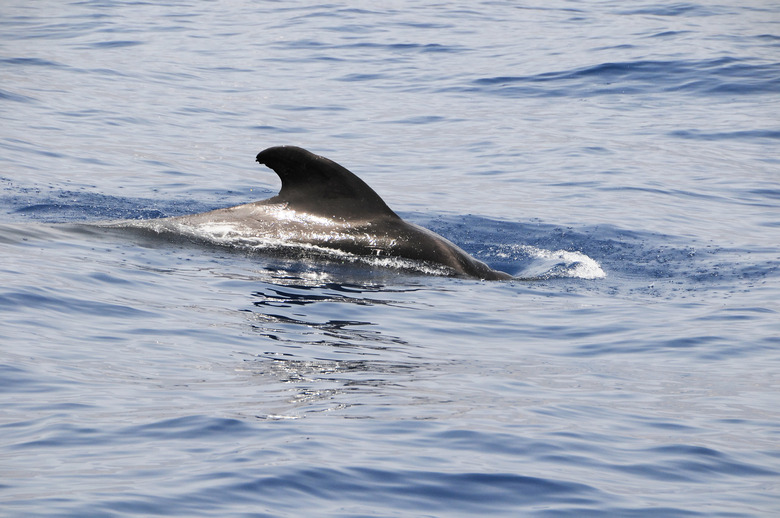Similarities Between Whales & Sharks
Whales and sharks are two highly recognizable and fascinating groups of large marine animals. Though they certainly have their differences, there are actually many similarities between whales and sharks. From the toothy bottlenose dolphin to the filter-feeding humpback whale, different whale species share a lot in common with sharks! Sharks might not have warm blood, produce milk or breathe air, but the two groups share a surprisingly similar lifestyle, body shape and diet.
Aquatic Lifestyle
Aquatic Lifestyle
Even though whales are mammals and breathe air, they share a common lifestyle with sharks in that they live their entire lives in the water. This actually differs from most other mammals, including other marine mammals. Most other marine mammals, such as seals or sea lions, spend at least some of their time out of the water – usually to rest or bear their young. However, whales and dolphins never leave the water – they sleep, breed and give birth in the water just like sharks.
Fusiform Body Shape
Fusiform Body Shape
Though some exceptions exist with bottom-dwelling shark species, sharks and whales generally share the same body shape. In fact, a fusiform body shape is one of the most noticeable similarities between whales and sharks. Having a fusiform body shape, which is tapered and torpedo-like, helps these animals move through the water in the most efficient way possible. The streamlined shape reduces drag through the water, letting them swim faster and use less energy.
Shark and whale bodies are not the only examples of a fusiform body shape. Many other fish species also have this useful adaptation, such as tuna or barracuda.
Similar Diets
Similar Diets
Another key factor in the similarities between whales and sharks is their diet. The two groups often share a similar dietary strategy as well, depending on the individual species. The toothed whales, such as orcas and dolphins, use their sharp teeth to actively hunt and catch fish, squid, sharks and other prey. The larger species, such as the orca, also hunt marine mammals and birds, just like the larger shark species.
But the active predators aren't the only examples of the shark and whale diets coinciding. Both groups also have individuals who use filter feeding rather than more active hunting strategies.
Filter Feeding
Filter Feeding
In whales, many of the largest species feed on very small prey, such as plankton and krill, using filter feeding. They open their mouths to take in water and use long sheets of baleen to filter their prey out. The baleen is made up of keratin, the same material as your fingernails and hair. Some examples of filter-feeding whales include blue whales, humpback whales and right whales.
The same is true for some of the largest shark species. They take in large amounts of seawater and filter out small plankton and other micro-organisms. Instead of baleen, filter-feeding sharks use gill rakers in a similar fashion. Some examples of filter-feeding sharks include basking sharks and whale sharks.
Tail Shape
Tail Shape
Shark and whale tail shapes are both similar and different. Unlike some other fish or marine mammals, sharks and whales both have a curved tail fin shape. Though the precise shape of the tail fin varies in sharks, the shape generally curves and tapers at the tips for both groups. However, the difference between the two tail forms lies in the orientation of the fin.
In sharks, the tail fin has a vertical orientation, and they swim through the water using a side-to-side motion. In whales and dolphins, the tail fin has a horizontal orientation, and they propel themselves using an up-and-down motion. However, despite their different swimming methods, the efficiency and power of both tail fins are quite similar.
References
- SeaWorld Parks & Entertainment: Sharks & Rays – Physical Characteristics
- SeaWorld Parks & Entertainment: Bottlenose Dolphins – Physical Characteristics
- SeaWorld Parks & Entertainment: Sharks & Rays – Diet & Eating Habits
- Whale & Dolphin Conservation USA: What Do Dolphins Eat?
- Dolphin Research Center: Physiology
- Animal Diversity Web: Basking Shark
- Animal Diversity Web: Whale Shark
- Whale & Dolphin Conservation USA: What is Baleen?
Cite This Article
MLA
Zinni, Yasmin. "Similarities Between Whales & Sharks" sciencing.com, https://www.sciencing.com/similarities-between-whales-sharks-8631445/. 30 September 2021.
APA
Zinni, Yasmin. (2021, September 30). Similarities Between Whales & Sharks. sciencing.com. Retrieved from https://www.sciencing.com/similarities-between-whales-sharks-8631445/
Chicago
Zinni, Yasmin. Similarities Between Whales & Sharks last modified March 24, 2022. https://www.sciencing.com/similarities-between-whales-sharks-8631445/
